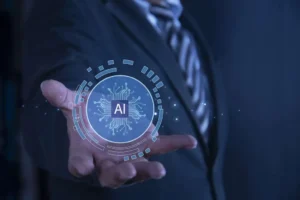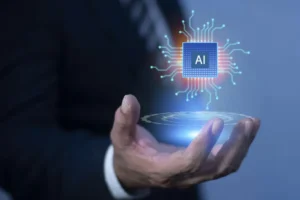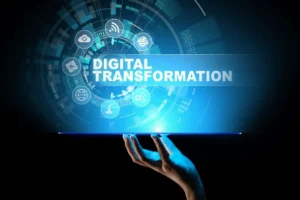A Beginner’s Guide to Understanding IoT in Healthcare
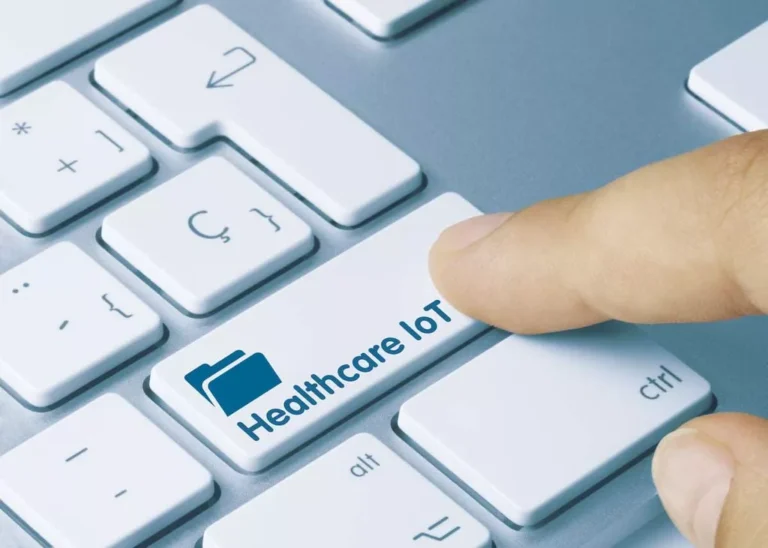
The global healthcare systems are facing new challenges. Aging populations, increasing instances of chronic and infectious illnesses, and other factors drive medical professionals to look into brand-new methods for delivering high-quality treatment at lower prices. The Internet of Things in medicine creates new possibilities for patients, service providers and healthcare experts. Nearly 200 million IoMT devices will be installed globally by 2025, according to Statista research. Technological developments in the IoT unlock the potential to raise the standard of medical services. Today, medical institutions utilize sensors, smart gadgets, and software to access prescription records, equipment counts, and remote patient monitoring (RPM). In the article, we’ll touch on IoT in medicine, its areas of use, and industry-specific difficulties.
What Is IoT in Healthcare?
The Internet of Things (IoT) comprises a network of physical items and devices capable of sharing info. The Internet of Medical Things (IoMT) is a networked infrastructure of medical solutions, software programs, systems, and services. The function and interaction of medical tech in healthcare are quickly changing due to IoMT. Specifically, the interplay of sensors and technologies enables medical establishments to amp up patient care from a distance, optimize clinical operations, and manage workflow.
The complex software solutions system comprises hardware, software, sensors, and communication channels. Numerous systems’ operations are tracked in real-time. IoT enables faster diagnosis of illness, more effective care, and the supervising of patient health indicators.
Today, you will find various IoT-connected tools. Wearable devices, subcutaneous implants, clothes, and crucial physiological indicators illustrate the scope of sensors and the signals to which they respond. These gadgets can instantly send data to computers, cell phones, and other wireless devices.
Utilizing IoT has several benefits. It includes lowering the possibility of medical mistakes, continuous medical supervision, and high-quality therapy with innovative healthcare solutions. Moreover, it allows for modifying technology and treatment approaches developed decades ago. It creates cutting-edge approaches for physicians, individuals seeking medical care, and healthcare establishments.

We are confident that we have what it takes to help you get your platform from the idea throughout design and development phases, all the way to successful deployment in a production environment!
Why Is IoT in Healthcare Important?
Research organization Transforma Insights forecasts that by the end of 2030, the healthcare sector will contribute $4.7 billion, constituting 17% of the total IoT market growth. Presently, here are several ways this tech is revolutionizing medicine:
- It builds electronic systems that store and handle patient data. It ensures the quality and integrity of medical info, simultaneously facilitating its accessibility and fostering communication between doctors and patients.
- Patients may have direct real-time monitoring from their homes or other locations using linked medical equipment. Those suffering from long-term illnesses can have their oxygen consumption, heart rate, or other characteristics measured by wearable technology. Physicians can keep an eye on these indicators and react to any odd fluctuations.
- IoT also contributes to the improvement of patient care and the therapeutic procedure. Smart gadgets might automatically remind users to take their prescriptions or undergo treatments. Doctors can access information about a patient’s condition and utilize it to offer appropriate therapy and recommendations.
- Patients may now use smartphone apps or video chat to consult remotely with physicians. Those who live in distant places or have limited access to healthcare will find this very helpful.
IoT in healthcare raises benchmarks of healthcare. It’s revolutionizing the industry by bringing ease, efficiency, and accuracy to everything from eHealth to remote monitoring and therapy optimization. We may anticipate more developments and shifts in how medics provide healthcare via IoT. Therefore, if you’d like to join the journey, consider using Global Cloud Team IoT software development services. We offer innovative solutions that spruce up patient care, facilitate administration, and enhance telehealth.
Examples of IoT in Healthcare
Advanced health AI technologies keep up their rapid growth and offer ease in resolving the daily issues faced by users, physicians, and hospitals. Let’s look at the most typical IoT examples today.
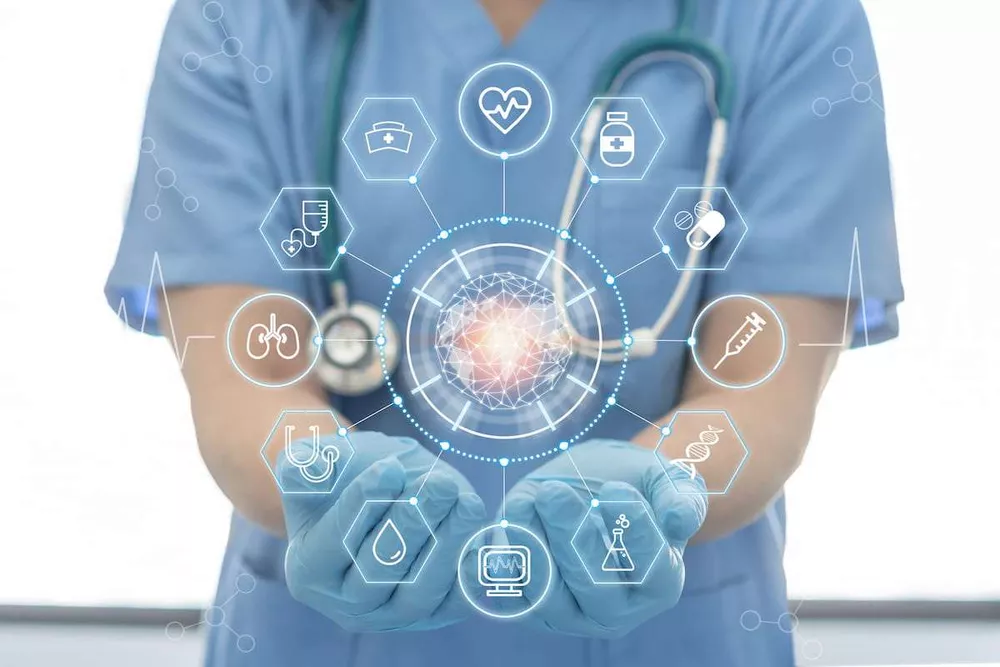
Telemedicine or remote appointment
The COVID-19 epidemic has changed our lives and the way we visit doctors. This time brought a unique development – telemedicine. You may consult and reach patients via video conversations, but this needs information about their condition. The MEDUCORE Standard gadget aids in telemetry or the remote transfer of patient health info. In any Wi-Fi access point scenario, it functions by uploading files to the server.
Medication tracking
For older people, AltumView has created an intelligent medical warning system. It consists of an app, a cloud server, and a Cypress smart visual sensor. It’s a smart IoT tool tracking the movements of senior citizens using sophisticated DL algorithms powered by a potent medical AI processor. It immediately notifies family members or medics in an emergency. Hospitals, elderly care institutions, and senior citizens (particularly single dwellers) can all benefit from this system.
Enhancing patient care
Clinics benefit from smart technology. They facilitate and expedite the resolution of patient care concerns. Nurses can more quickly and effectively assign patients to beds, manage the number of patients, and keep tabs on their whereabouts around the hospital using GE Healthcare’s AutoBed technology. It uses computer vision, infrared ports, and identifying tags to function.
Insulin pens
The smart insulin pen is another tool making diabetes patients’ lives better. Pen caps like Gocap, InPen, and Esysta can automatically log insulin injections’ type, quantity, and timing and suggest the appropriate injection type and time. The gadgets connect to a smartphone app that allows users to keep historical data and calculate their insulin dose. They record the meals and blood sugar readings to observe the relationship between the food and insulin dosage.
What Are the Primary Challenges?
The merits of IoT in healthcare are evident. However, there are certain obstacles to navigate. Let’s delve into the primary ones:
- User experience. Creating software and medical gadgets that are simple for people to use might be a time-consuming and expensive task. Furthermore, data gathering is limited or compromised when patients remove or misuse poorly designed hospital IoT devices.
- Data leaks. Breach circumstances may result in the unlawful collection or release of Personal Health Information, jeopardizing patient confidentiality. IoT systems can have data leaks due to factors including inadequate security, human error, insider threats, and intentional cyberattacks.
- Incomplete device profiles. Healthcare Delivery Organizations (HDOs) have issues keeping their device profiles current. Differentiated ways of identification and varied device naming rules impede manual efforts. Things like device kind, version, and settings become more challenging due to accessibility difficulties. Cyber risk in healthcare environments rises due to HDOs’ use of generic discovery technologies and antiquated processes that might lead to losing important device data.
- Cost consideration. Growing healthcare expenses are still an issue. IoT has great promise, but it hasn’t done a good job of addressing cost difficulties. To fully reap the benefits of IoT in healthcare, stakeholders need to work together to increase accessibility and improve its cost-effectiveness.
Even though IoT can revolutionize healthcare, it’s critical to solve its issues. Solve these questions so that you create a product that will be accessible to all segments of society and guarantee the full realization of the benefits of IoT.
Reminders for Securing IoT in Healthcare
Navigating IoMT security requires careful consideration of critical factors. Data transmitting over the internet faces heightened risks compared to private networks, especially given its distributed nature across multiple systems. It creates simultaneous attack variables. OEMs play a crucial role by adhering to the industry’s best techniques, ensuring the resilience of IoMT. Administrators should employ up-to-date encryption protocols and prioritize distinctive, intricate passwords for SSL certificate access on remote systems.
The variable nature of IoMT security poses challenges, and there’s no universal solution against all types of threats. Nevertheless, a critical step involves maintaining a clear understanding of devices on a network to address potential disruptions to their operations proactively.
Summing Up
IoT comes to the fore of the medical industry since it provides advantages like real-time tracking and remote medical support. IoT adoption, including wearables and ingestible sensors, is growing despite security concerns. Healthcare practitioners value this tech because it can save costs, promote preventative care, and enhance patient outcomes.
With GlobalCloudTeam’s artificial intelligence solutions and IoT experts, you may unleash the promise of healthcare. With our leading-edge technology, you may improve telemedicine, expedite administration, and elevate patient care. The results you’ll have leveraging with GlobalCloudTeam? Reduced errors in the healthcare system, streamlined RPM and effectively managed data. Join us to contribute to a better, more interconnected healthcare future.
Top Articles
What is Hyperautomation: A Comprehensive Overview of Key Components
I am here to help you!
Explore the possibility to hire a dedicated R&D team that helps your company to scale product development.



